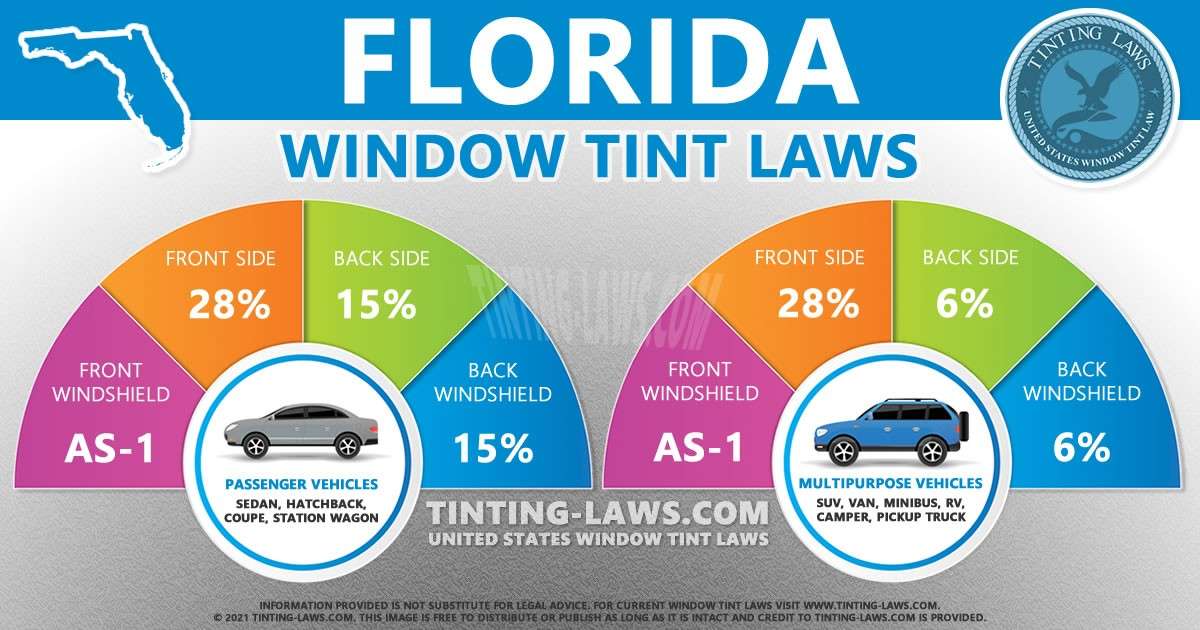Florida Window Tinting Laws
Car window tinting laws in Florida were enacted in 1991.
We have provided all the necessary information about your car’s window tint, including how dark or reflective the tint is allowed in your state.
There are also additional car window tinting rules and regulations in Florida so make sure you read all about it below.
Window tint darkness in Florida
The percent of visible light allowed through your car windows is called VLT: Visible Light Transmission.
The percentage of light allowed through your film and glass in Florida is very specific and different for sedan cars and SUV cars or vans.
Tint darkness for sedans:
- Windshield: Non-reflective tint is allowed above the manufacturer’s AS-1 line.
- Front Side windows: Must have a VLT of at least 28%.
- Back Side windows: Must have a VLT of at least 15%.
- Rear Window: Must have a VLT of at least 15%.
Tint darkness for SUV and vans:
- Windshield: Non-reflective tint is allowed above the manufacturer’s AS-1 line.
- Front Side windows: Must have a VLT of at least 28%.
- Back Side windows: Must have a VLT of at least 6%.
- Rear Window: Must have a VLT of at least 6%.
Florida window tint laws were updated in 2015.
Many resources and local FL tint business have NOT updated info on their websites, but we have.
Please ensure you are reading current info.
Window tint reflection in Florida
Window tint can reflect incoming light and reduce glare and heat.
Florida window tint law permits a certain window reflection when using a tint so make sure you pay attention to this as well.
Tint reflection for sedans:
- Front Side windows: Must not be more than 25% reflective.
- Back Side windows: Must not be more than 35% reflective.
Tint reflection for SUV and vans:
- Front Side windows: Must not be more than 25% reflective.
- Back Side windows: Must not be more than 35% reflective.
Other Florida window tint rules and regulations
Florida does have several other important laws, rules and regulations pertaining to window tinting. They include the following:
- Side Mirrors: Dual side mirrors are required in case any back windows are tinted.
- Restricted Colors: Florida does not permit any colored tint.
- Certificates: Film manufacturers don’t need to certify the film they sell in this state.
- Stickers: The sticker to identify legal tinting is required on the inside of the driver’s side door jamb.
- Medical Exceptions: Florida allows medical exemptions for special tint. For more details about the specific terms of the exemption, consult your state law.
Keep in mind that Florida tinting laws and regulations may be interpreted differently in your county or place of residence.
We always recommend double-checking our information with your local DMV or law enforcement authorities.

Our information about window tint laws in Florida was last updated in 2024.
Tinting laws in Florida were enacted in 1991.
In case any of our info provided is not up to date or correct be sure to contact us so we can fix it. Thanks!
Trusted industry leader in providing accurate window tint laws. Share with confidence:
State of Florida Info
Florida is a state in the southeastern region of the United States, bordered to the west by the Gulf of Mexico, to the north by Alabama and Georgia, to the east by the Atlantic Ocean, and to the south by the Straits of Florida.
Florida is the 22nd most extensive, the 4th most populous, and the 8th most densely populated of the 50 United States.

The state capital is Tallahassee, the largest city is Jacksonville, and the largest metropolitan area is the Miami metropolitan area.
Capital: Tallahassee
Population: 21,781,128
Area: 65,755 sq mi (170,304 km2)
Cities in Florida: Miami, Orlando, Tampa, Fort Lauderdale, Jacksonville, Key West, Sarasota, Naples, Fort Myers, Tallahassee, St. Petersburg, Miami Beach, St. Augustine, Destin, West Palm Beach, Boca Raton, Pensacola, Daytona Beach, Clearwater, Kissimmee, Gainesville, Bradenton, Hollywood, Palm Beach, Cape Coral, Marco Island, Ocala, The Villages, Port St. Lucie, Sanibel, Delray Beach, Panama City Beach, Panama City, Vero Beach, Lakeland, Cocoa Beach, Melbourne, Pompano Beach, Winter Park, Sunrise, Venice, Punta Gorda, Fort Myers Beach, Jupiter, Coral Gables, Everglades, Stuart, Pembroke Pines, Clearwater Beach, Islamorada
Counties in Florida: Alachua, Baker, Bay, Bradford, Brevard, Broward, Calhoun, Charlotte, Citrus, Clay, Collier, Columbia, DeSoto, Dixie, Duval, Escambia, Flagler, Franklin, Gadsden, Gilchrist, Glades, Gulf, Hamilton, Hardee, Hendry, Hernando, Highlands, Hillsborough, Holmes, Indian River, Jackson, Jefferson, Lafayette, Lake, Lee, Leon, Levy, Liberty, Madison, Manatee, Marion, Martin, Miami-Dade, Monroe, Nassau, Okaloosa, Okeechobee, Orange, Osceola, Palm Beach, Pasco, Pinellas, Polk, Putnam, Santa Rosa, Sarasota, Seminole, St. Johns, Sumter, Suwannee, Taylor, Union, Volusia, Wakulla, Walton, Washington
Tint law references:
Florida 2016 Statutes sections 316.2951 through 316.2956: (see sections 316.2951 to 316.2956)